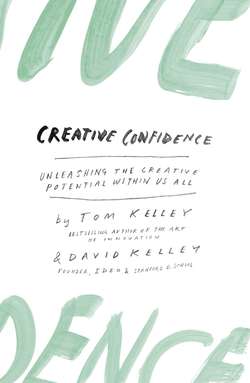Читать книгу Creative Confidence: Unleashing the Creative Potential Within Us All - David Kelley - Страница 28
DRAWING CONFIDENCE
ОглавлениеPeople who believe they lack creativity often insist, “I can’t draw.” More than any other skill, people see drawing as a litmus test for creativity. Everyone acknowledges that certain skills, like playing the piano, take years of training. But a common misperception is that we’re either good at drawing, or we’re not. In reality, drawing is a skill that you can learn and improve through practice with a little guidance.
A sketch is often worth a thousand words. Great communicators in today’s fast-paced business world should never hesitate to reach for a marker pen. Unfortunately, most people shy away from the opportunity to sketch out their idea on the board. Or when they do, they preface their efforts with a disclaimer about their lack of drawing ability. Dan Roam, author of The Back of the Napkin and an expert on the art of visual thinking, says that roughly 25 percent of the businesspeople he works with are reluctant to even pick up a marker (he calls them “red pen” people). And another 50 percent (“yellow pen” people) are only comfortable highlighting or adding details to other people’s drawings.
Dan helps people get over their hesitation to grasp the marker pen and approach the whiteboard by lowering the barrier. He does this by dissociating artistic drawing from drawing for communication. One of the lessons in his web-based “Napkin Academy” is called “How to Draw Anything.” He insists that everything you ever need to draw on a whiteboard—or on a napkin—can be deconstructed into five basic shapes: a line, a square, a circle, a triangle, and an irregular shape he calls a blob. Next, he explains drawing fundamentals—such as size, position, and direction—that can seem comically simple yet still go underused. On the topic of size, for example, if you make one object bigger than another, your audience will understand that this object is either closer or—you guessed it—larger. And so it goes.
SKETCHING PEOPLE
(photo/illustration credit 2.2)
If you can draw the five shapes above (and we bet you can), then visual thinker Dan Roam says you are on your way to being able to draw anything—including people. With a focus on drawing for communication—not art—Dan can amp up your sketching skills in a matter of minutes. For example, Dan has three ways of drawing people (as he demonstrates for us below), depending on what you want to get across: 1. Stick figures are very simple and convey mood or emotion—especially if you make the head one third the total size of the person, so you have more room for showing expression; 2. Block figures add a rectangular torso and are good for showing motion or different body postures; 3. Blob figures (also known as “star” people) don’t show emotion or action well but provide a quick way to draw groups and relationships.
